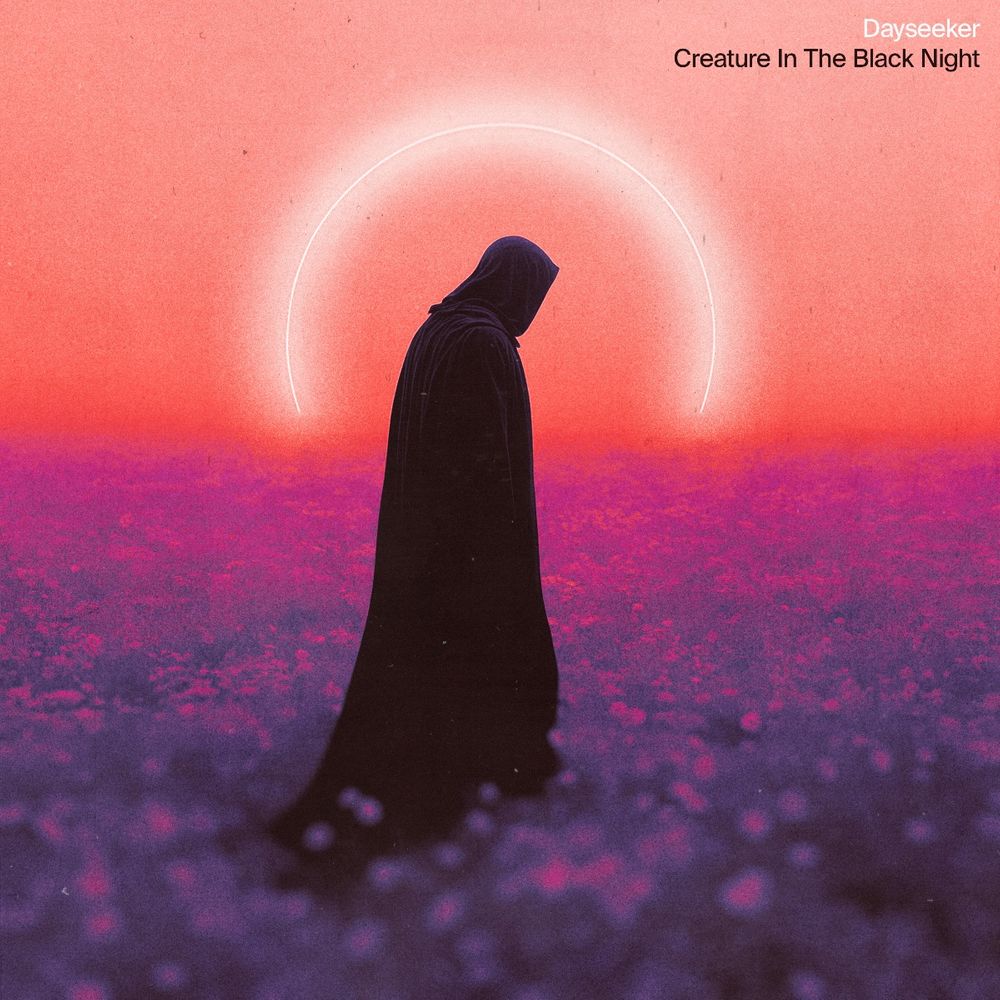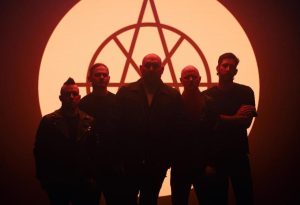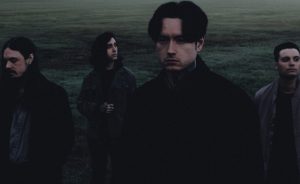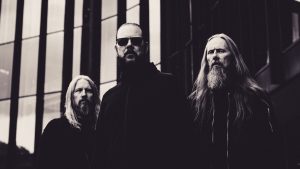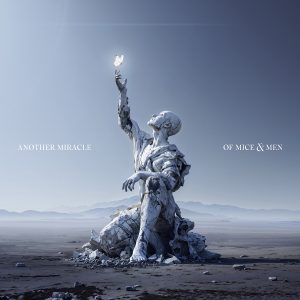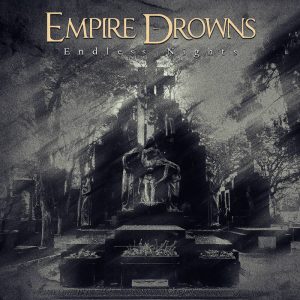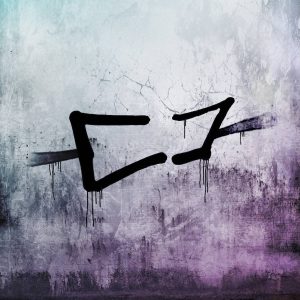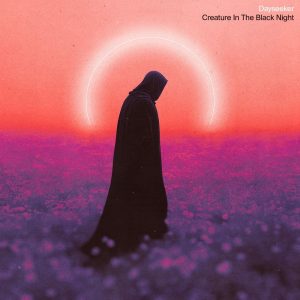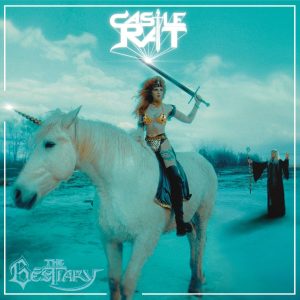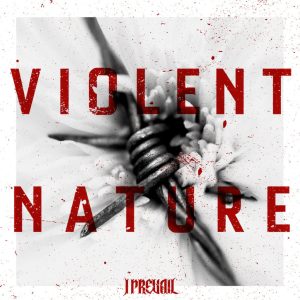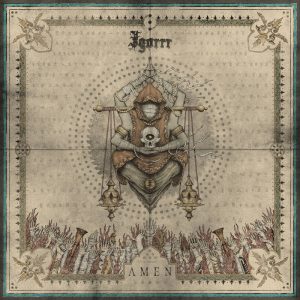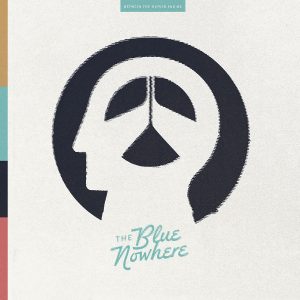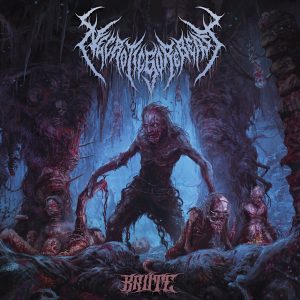
[Critique de l’album]
Dayseeker – Creature in the Black Night
Une plongée lumineuse dans les ténèbres
Dayseeker, c’est souvent un band qu’on considère comme étant du sad rock. Mais cette étiquette, bien qu’attirante, ne suffit pas à capter toute la dimension que le groupe développe depuis plusieurs années : formé en Californie du Sud, forgé dans l’adversité, Dayseeker a grandi, mûri, mais surtout évolué, passant de jeunes espoirs post-hardcore à l’un des groupes les plus habiles dans la fusion d’ambiances émotionnelles intenses et de styles nuancés. La musique est devenue pour le groupe un exutoire, un ancrage. Ces thèmes résonnent d’autant plus fortement quand on plonge dans le nouvel album.
C’est dans ce contexte que s’inscrit Creature In The Black Night, paru le 24 octobre dernier via Spinefarm Records. Produit par Daniel Braunstein (Spiritbox) et mixé par Zakk Cervini (Blink-182, Bring Me The Horizon, Lorna Shore), l’album est décrit comme la version la plus immersive et intentionnelle du groupe à ce jour : cinématique, mystérieuse et plongée dans une tension émotionnelle sombre, mais magnétique.
La pochette en dit long : on y voit une silhouette entièrement noire se tenant dans un décor orangé et rosé, un ciel crépusculaire ou un lever de soleil voilé. Il y a dans cette image une dualité que l’album explore du début à la fin : une part d’ombre en nous, présente même lorsque le soleil se lève. Cette silhouette, seule, nous interpelle d’une manière inquiétante et invitante à la fois. On perçoit déjà que la lumière et l’obscurité ne sont pas opposées, mais se superposent.
Cet album s’inscrit dans une thématique bien imposante : l’imagerie du faucheur, l’atmosphère oppressante, l’idée d’un voyage à travers la nuit intérieure. Parfait pour cette spooky season. On y retrouve également une volonté de retour aux racines, plus de riffs, plus de screams.
L’album s’ouvre sur une valse — littéralement avec Pale Moonlight. Dès les premières notes, une envie de danser, de vivre, de se laisser porter par la musique m’envahit. Les paroles sont envoûtantes, presque magnétiques. On comprend rapidement que le groupe ne cherche pas seulement à séduire nos oreilles, mais à frapper droit au cœur.
Puis, l’ambiance se fait plus sombre, plus viscérale grâce au morceau Creature In The Black Night, éponyme au titre de l’album. Cette deuxième pièce déploie un son à la fois catchy et mélancolique, parfaitement aligné avec la pochette de l’album : une silhouette solitaire sous un ciel crépusculaire. Tout est dit — la beauté dans la solitude, la lumière qui s’éteint doucement.
Vient ensuite une chanson aux lyrics puissants, presque cinématographiques : Crawl Back To My Coffin. Dayseeker y tisse une histoire qu’on visualise facilement à l’écran : un chemin vers un mince rayon de lumière, qui vacille, qui résiste. On y sent l’épuisement, la lutte, mais aussi une forme d’espoir fragile.
La quatrième chanson Shapeshift est, sans conteste, la plus marquante de l’album selon moi. Rythme parfaitement construit, paroles hypnotisantes, émotion palpable. Rory Rodriguez livre une performance viscérale, jouant avec les silences et les reprises de puissance. Le drop final est un cri du cœur — une invitation à se battre, à se libérer. Le mélange entre rage et douceur est tout simplement sublime.
La cinquième piste Soulbrun, quant à elle, me laisse plus mitigée. Si la douleur est présente dès les premières notes, le contraste entre la voix douce et le rythme rapide coupe un peu l’émotion. Le morceau devient répétitif sans être véritablement accrocheur. Il manque une étincelle, ce petit quelque chose qui fait vibrer.
Heureusement, la suivante Bloodlust rattrape tout. Dès l’intro, on sent que quelque chose d’intense se prépare. Chaque couplet est un gouffre, une histoire, et le refrain porté par le scream « Bloodlust » frappe en plein ventre. Les riffs de guitare, secs et précis, ponctuent une mélodie qui oscille entre brutalité et douceur. Une réussite totale.
La septième chanson Cemetery Blues nous plonge dans une atmosphère de mystère. Le rythme, parfois saccadé, parfois harmonieux, rend la pièce unique. On y décèle un appel à l’amour, une peur viscérale de l’abandon. Le scream du milieu intensifie ce cri intérieur. Si le message m’a touchée, la chanson, elle, m’a un peu moins marquée.
La huitième Nocturnal Remedy m’a laissée perplexe. Le contraste entre la lourdeur instrumentale et la voix aiguë du chanteur déstabilise. Ce n’est pas désagréable, mais elle ne se distingue pas vraiment dans la globalité de l’album.
Puis arrive la neuvième The Living Dead : une douce harmonie, presque éthérée. Les instruments se font discrets, laissant toute la place à la voix et au texte — un cœur brisé, une âme fracassée. L’émotion est brute, sans artifice. C’est l’un de ces morceaux qui suspendent le temps.
La dixième Meet The Reaper poursuit cette ligne émotionnelle, mais sans le même impact. On ressent la souffrance, oui, mais elle semble plus contenue. Le groove du chant, appuyé par une batterie obstinée, est magnifique, mais la chanson aurait peut-être gagné à être placée ailleurs sur l’album. Sa proximité avec The Living Dead crée une cohérence thématique — celle d’une âme qui s’éteint — mais les rythmiques se ressemblent un peu trop pour vraiment surprendre.
Enfin, la dernière chanson Forgotten Ghost referme l’album comme la fin d’un film. On y entend une vague d’espoir, un écho à toutes les émotions traversées précédemment. C’est une conclusion apaisante, presque lumineuse, qui vient boucler la boucle. Moins dans mon style personnel, certes, mais difficile de ne pas reconnaître la beauté du geste.
▶ Écoute/Stream/Commande: https://dayseeker.lnk.to/CreatureInTheblacknight
https://dayseeker.band/
https://www.facebook.com/dayseeker
https://www.instagram.com/dayseeker
Playlist YouTube:
ENGLISH version
Dayseeker – Creature in the Black Night
A luminous plunge into darkness
Dayseeker has often been described as a sad rock band. But that label, while appealing, barely captures the full dimension the California-based band has developed over the years. Forged through adversity, Dayseeker has grown, matured, and evolved — moving from post-hardcore hopefuls to one of the most skilled bands at blending emotional depth with stylistic nuance. For them, music has become both a release and an anchor. Those themes resonate even more powerfully on their new album.
That brings us to Creature in the Black Night, released on October 24 via Spinefarm Records. Produced by Daniel Braunstein (Spiritbox) and mixed by Zakk Cervini (Blink-182, Bring Me The Horizon, Lorna Shore), the album is described as the band’s most immersive and intentional work to date — cinematic, mysterious, and steeped in dark yet magnetic emotional tension.
The cover says it all: a pitch-black silhouette stands against an orange and pink background, somewhere between dusk and dawn. There’s a duality here that the album explores from start to finish — the idea that darkness exists even when the sun rises. That lone figure is both unsettling and inviting, reflecting the coexistence of shadow and light.
The album’s concept embraces powerful imagery: the figure of the reaper, an oppressive atmosphere, and the notion of a journey through one’s inner night — perfectly fitting for the spooky season. There’s also a sense of return to the band’s roots, with heavier riffs and more screams.
The record opens with a literal waltz — Pale Moonlight. From the very first notes, there’s a desire to move, to live, to surrender to the music. The lyrics are captivating, almost magnetic. It quickly becomes clear that Dayseeker isn’t just aiming to please the ears, but to strike straight at the heart.
The mood then darkens and becomes more visceral with Creature in the Black Night, the title track. This second song balances catchiness and melancholy, perfectly aligned with the album art — a solitary figure beneath a twilight sky. It captures the beauty of solitude, the slow fading of light.
Next comes Crawl Back to My Coffin, with its powerful, almost cinematic lyrics. Dayseeker weaves a vivid narrative — a path toward a flickering light that struggles to stay alive. You can feel the exhaustion, the fight, but also a fragile thread of hope.
The fourth track, Shapeshift, is arguably the album’s standout. The rhythm is perfectly constructed, the lyrics hypnotic, the emotion palpable. Rory Rodriguez delivers a visceral performance, playing with silence and surges of power. The final drop is a cry from the heart — an invitation to fight and to break free. The balance between rage and tenderness is simply sublime.
Track five, Soulbrun, leaves a more mixed impression. The pain is there from the first notes, but the contrast between the soft vocals and fast pacing somewhat dulls the emotion. It becomes repetitive without truly hooking the listener. It lacks that spark — the magic that makes you vibrate.
Thankfully, Bloodlust makes up for it. From the intro, you can sense something intense coming. Each verse feels like a descent, a story unto itself, and the chorus — driven by the screamed “Bloodlust!” — hits right in the gut. The sharp, precise guitar riffs punctuate a melody that swings between brutality and beauty. A total success.
Seventh comes Cemetery Blues, shrouded in mystery. Its rhythm alternates between choppy and harmonious, giving the song a unique feel. There’s a yearning for love here, a visceral fear of abandonment. The mid-song scream amplifies the emotional outcry. While its message is touching, the song itself leaves a slightly lesser mark.
Nocturnal Remedy follows, and I found it puzzling. The contrast between the heavy instrumentation and the high-pitched vocals feels disorienting. It’s not unpleasant, but it doesn’t quite stand out within the album’s flow.
Then comes The Living Dead: a soft, almost ethereal harmony. The instruments step back, leaving the spotlight to the voice and lyrics — a broken heart, a shattered soul. The emotion is raw and unfiltered. It’s one of those tracks that seem to stop time.
Meet the Reaper continues in the same emotional vein but with slightly less impact. The pain is present, but it feels more restrained. The vocal groove, supported by a relentless drum pattern, is stunning, though the song might have worked better placed elsewhere on the record. Its proximity to The Living Dead makes thematic sense — an extinguished soul — but musically, their rhythms feel a bit too similar.
Finally, Forgotten Ghost closes the album like the ending of a film. There’s a wave of hope, an echo of all the emotions explored before. It’s a soothing, almost luminous conclusion that ties everything together. Not exactly my personal favorite style-wise, but it’s hard not to admire the beauty and sincerity of the moment.
